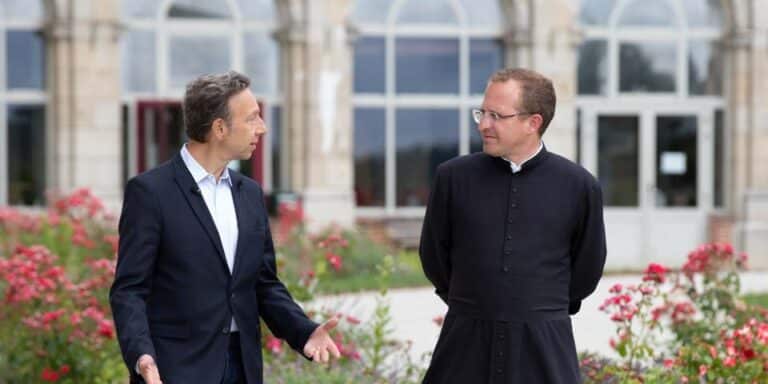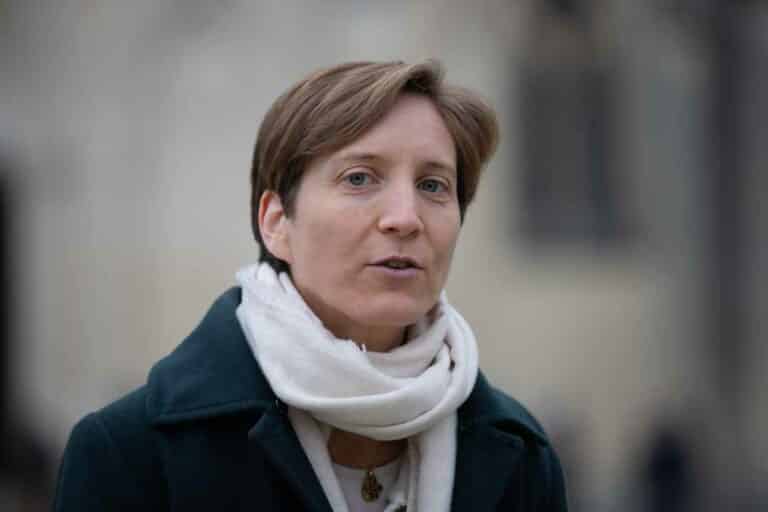Lecture about Purgatory, by Msgr. Celestino Migliore, Apostolic Nuncio to France, on the feast of the Ascension of Our Lord, on May 26, 2022.
On January 11, 2020, Pope Francis appointed Archbishop Celestino Migliore Apostolic Nuncio to France. Until recently, he assumed his charge in the Russian Federation and in Uzbekistan. He was born on July 1, 1952 in Cuneo, in the Italian Piedmont, and was ordained a priest on June 25, 1977 for the same diocese whilst studying Canon Law, which led him to a doctorate. Forty years ago, in 1980, he entered the diplomatic service department of the Holy See, and was posted on duty at the papal local offices in Angola, the United States, Egypt and Poland. Finally, he was at the Vatican.
Complete text of Msgr. Celestino Migliore’s lecture.
I rejoice at having been offered the opportunity to exchange with the faithful of the parish and the pilgrims attending the “Heaven’s pilgrimages” programme, who have all come to pray here today to Our Lady Liberator of the souls in purgatory.
As I said in the homily during Mass, I am amazed at the thirst for transcendence on the part of Christians during the recent pandemic crisis periods. Thus the large attendance in your Heaven’s pilgrimage organized on the Ascension day is a significant illustration. The need for prayer, liturgy, adoration as well as the craving for teaching and guidance have never been so intense. You, pilgrims, are offering to society the key to the future through your thirst for God to be celebrated, proclaimed and magnified by means of the Word of God made tangible.
We also prayed and shall continue to pray to Our Lady of Deliverance of the souls in Purgatory.
You have probably already heard much about purgatory. Yet it is always helpful to review a few points about this very topic, which, nowadays, is often kept under silence.
Already eleven years ago, during the general audience held on Wednesdays, Pope Benedict XVI explained what purgatory is about; he found inspiration in the thought and life of .St. Catherine of Genoa’s life and reflexion.
Catherine was an Italian mystic, and a visionary. She was renowned for her works of mercy towards the poor and the sick. She was proclaimed a saint about three hundred years ago; and is also known as the Purgatory Doctor as author of her famous Treatise on Purgatory.
In the second half of the 15th century, Catherine of Genoa’s epoch, purgatory was considered a demanding and laborious place of purification of the soul, and mandatory prior to entering paradise.
That purgatory should be a real place is a antique belief that remained so, until recently.
For Catherine, it was not so. She described purgatory not as an external fire in a physical place located in the depths of the earth, but as an internal fire, a divine flame that burns within the soul, essential to its purification so as be enabled to enjoy beatific vision in paradise. Immersed in this love, the soul undergoes the transitional period in a state of alert and conscious suffering.
Pope Benedict XVI totally agreed with her.
Some media seized his dialectic as a great piece of news, as if the Pope had not been referring to the innermost characteristic of purgatory, but had declared its evaporation, as if it had never existed. A fading that has already been taking place to a large extent in the Church’s usual discoursing, for several decades.
But the teaching of Benedict XVI states exactly the opposite: no vanishing of purgatory, but its genuine reality.
It is essential to note that Catherine, in her mystical experience, never received specific revelations about purgatory nor about souls undergoing purification. However, in her writings, the former remains a focal factor, and her way of describing it displays singular characteristics with regard to her time.
The first innovative feature concerns the “place” of purification for the souls. In her time, it was chiefly represented by means of location-related images as then it was assumed that purgatory was established in a certain spot. As far as Catherine is concerned, purgatory is not depicted as a mere background deep in the abyss of the earth, on the contrary, the fire is not exterior, but interior.
Purgatory is an innermost fire. The saint illustrates the soul’s path of purification towards full communion with God, drawing from her own experience of utter suffering for the committed sins, in correlation with the infinite love of God.
We should keep in mind that Catherine, like all saints, was not born one. Engaged at first in a carefree life, she became a saint through conversion. She was born into an aristocratic family and, as was customary at the time, her family forced her to marry a patrician so as to increase her family’s influence and wealth. During the first ten years of their marriage, the couple, unable to have children, used to live a carefree and worldly life. Until Catherine was seized by a spiritual conversion, buoyed by a mystical vision. Soon after, her husband was to convert as well. Both totally changed of life styles. They moved to a modest dwelling next to a hospital, after which the husband entered the Franciscan Third Order. Although Catherine’s mystical life was most intense, she fully engaged in a significant manner ministering to the poor and the sick.
So to come back to her conversion, Catherine all at once experienced the goodness of God, the abyssal distance between her and such magnanimity, thus she felt what seemed a fire burning in her innermost. It is this very fire that purifies, it is the inner fire of purgatory.
Here is another original feature of her thinking, compared to the belief prevailing in her time. In order to signal the path leading to purification and to conversion, she did not launch into stating the torments of purgatory as was custom at the time and probably still is nowadays. Quite the opposite: our Saint departed from her own inner life experience which she undertook on her way to eternity.
The soul, asserts Catherine, appears before God still bound by the desires and suffering originating in sin, which prevent it from enjoying the beatific vision of God. Catherine supports that God is so pure and so holy that the sin flawed soul cannot withstand His presence.
We too feel so far removed and so hindered, and hence, prevented from perceiving God. The soul, by then fully aware of God’s immense love and justice, suffers consequently from not having responded in an adjusted and liberal manner. Thus the very love for God becomes an innermost flame. It is love itself that purifies the soul from the dross of sin.
One can identify in Catherine the theological and mystical founts from which it was customary to draw from, at her time. In particular, the image of a golden thread that connects the heart of God to that of human beings. Once God’s purification of man is completed, He ties a thin thread of gold, i.e. His love, from His heart to a person’s, and tugs it so much so that one feels all at once “overwhelmed, defeated and out of self”. Thus the heart is subjugated by God’s love, which becomes the sole guide and motor of existence.
Catherine refers to this condition of elevation towards God and abandonment to His will, epitomized by the golden thread, in order to explicit the exertion of divine light on the souls in purgatory, a light that purifies them and take them up towards the marvels of God’s brilliant radiance.
The Saints’ personal experience of union with God, through which they gain such a profound insight of divine mysteries – where love and acquaintance are closely intertwined – significantly help theologians in their research and apprehension of the mysteries of faith, but also in their developing tangibly the mysteries, such as the topic of purgatory for example.
Nowadays, theologians are convinced that the blaze that, both at once, burns and saves is no less than Christ Himself, the Judge and Savior. Facing Him is the crucial part of the Judgment. Under His gaze, all lies dissolve. It is Christ’s encounter that consuming us, transforms and liberates us so that we may truly become who we are meant to be. What has been accumulated during one’s life can then turn out to be like dry straw, hollow conceit, and failure. Yet, salvation is in the suffering of this encounter, whereby the impurity and corruption of our being are made manifest. His gaze and the touch of His heart heal us by means of a transformation that is undoubtedly uncomfortable, “like through a blazing fire”.
Our way of living is not insignificant, yet our grime, our sins, do not tarnish us for ever more if, however, we remain attached to Christ, to truth and love. After all, this filth has already been consumed in Christ’s passion. At Judgement, when one stands before the Lord, one experiences and accepts the predominance of love over all evil, may it be in the world or within us. Suffering out of love thus becomes our salvation and our joy.
Obviously we cannot measure the extent of the transformation endured during such an encounter with stopwatches. It escapes earthly timekeeping as it is the “time of the heart”, the interval of the passage to the full communion with God in the Body of Christ.
Now, we come to the significant and the important character of your pilgrimage here today, and of our petitioning to Our Lady of Deliverance of the Poor Souls.
Already in Ancient Judaism, it was believed that prayers could help the deceased in their intermediary state. Let us merely recall the Book of Maccabees in the Bible. Hence praying, doing good deeds and almsgiving for the salvation of the departed have been intuitively adopted and included in the tradition of the Church.
By means of the Eucharist, praying and almsgiving, one can enable the departed souls to “refresh and chill out”. Love can reach out to the afterlife, offering to and receiving from one another as well as remaining bound to one another by the ties of affection beyond the confines of death, have all been but fundamental beliefs of Christianity throughout the ages; today still they remain a comforting fact.
Who would not feel the need to offer to one’s beloved departed tokens of kindness and gratitude and requests for forgiveness as well?
You might be wondering: if purgatory merely consists in being purified by fire through the encounter with Our Lord, Judge and Savior, how then can someone else’s prayer and sacrifice be of help? When reflecting on such a topic, we ought to recall that no one is ever an island, nor independent from others. No one stands alone, no one sins alone, no one gets saved alone. At all times, my life is impacted by others’: in what I think, say or do. Equally my life impacts theirs, in doing good just as much as in ill-doing.
Thus petitioning for someone is neither an alien nor an external offering for the beneficiary, even beyond death. By means of our intermingling with one another’s life, my marks of gratitude and prayers for a deceased can be beneficial to a certain extent during the purification process. No need to convert earthly time into God’s time for, in the communion of souls, our derisory worldly time is no more. Thus it is never too late to touch someone’s heart and never useless either. This supports why it is said that Our Lady Liberator of the poor souls touches hearts even beyond death.
It represents a major component of the Christian concept of hope. Our hope is always, for most part, turned towards others; only as such, is there truly hope for me. As Christians, we ought never wonder about “How may I save myself?” but we ought to reflect on “What can I do so that others may be saved so that the star of hope may also shine for them?” Only then, shall I have done my utmost in view of my personal salvation.
I began by quoting a catechesis of Pope Benedict XVI and I would like to stress that Pope Benedict XVI wrote the most compelling pages on purgatory in his encyclical letter entitled “Spe salvi“. It is his most intimate letter, and the only one that he wrote by hand, from first to last. Should you like to learn more, I do recommend you get to read it further, especially from section 44 to 48.




